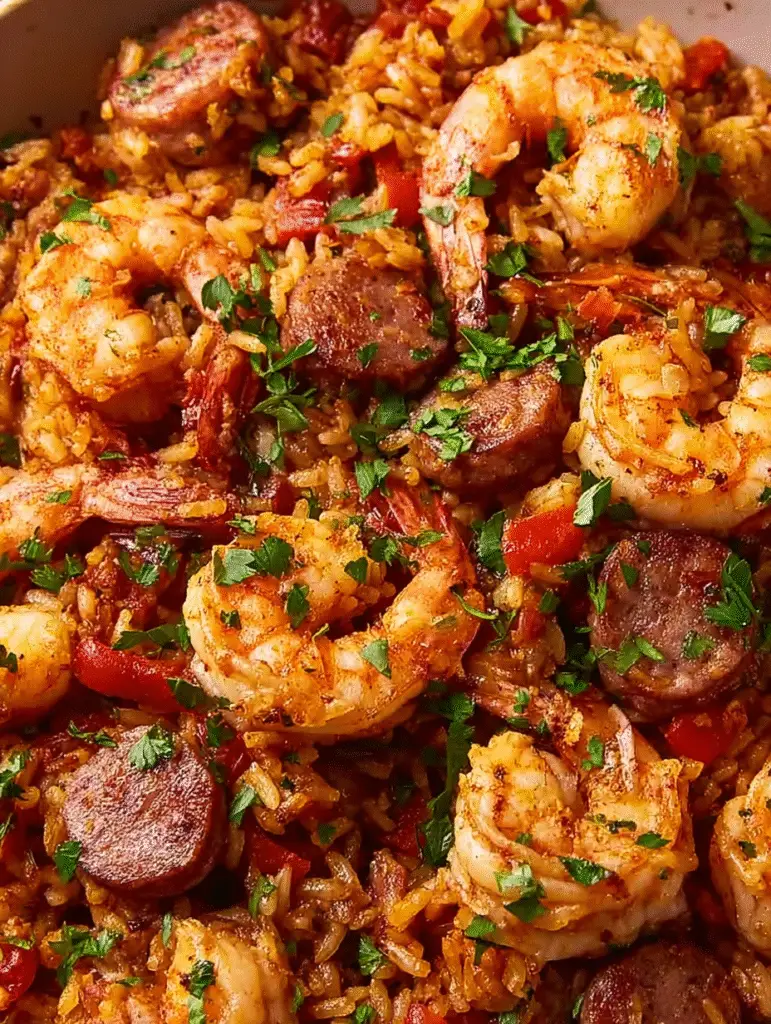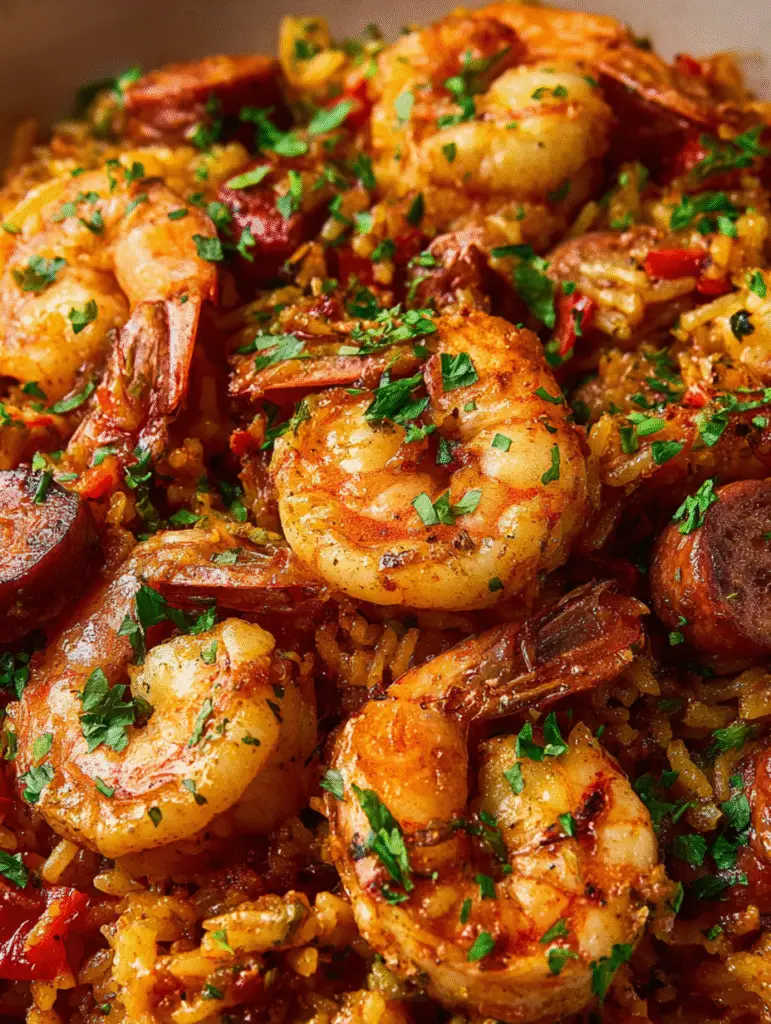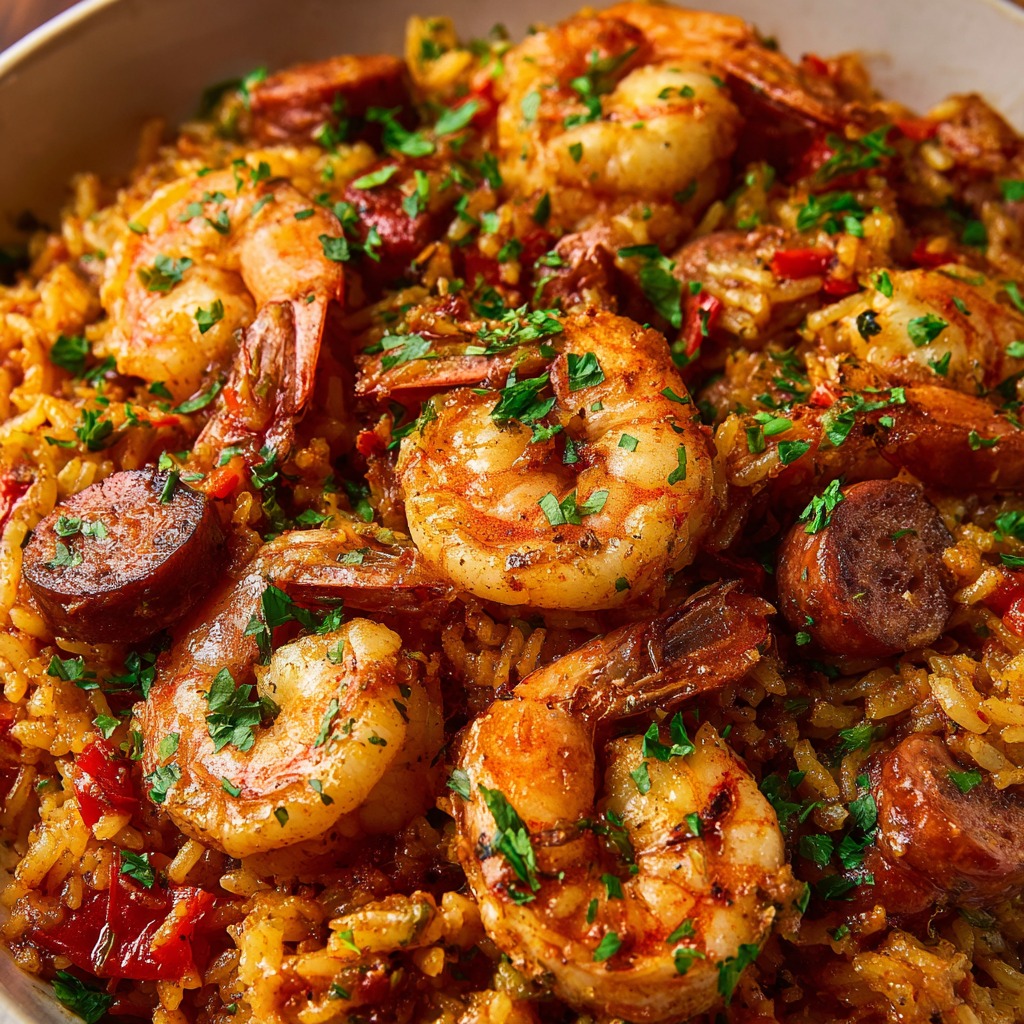Introduction
Few dishes capture the soul of Louisiana cooking quite like jambalaya—that magnificent medley of rice, meat, seafood, and vegetables all simmered together in perfect harmony. This Easy Jambalaya brings the authentic flavors of the Bayou straight to your kitchen, transforming simple ingredients into something truly extraordinary with minimal effort and maximum flavor.
What makes this recipe particularly special isn’t just its incredible taste—it’s the magic of one-pot cooking that delivers restaurant-quality jambalaya without the mountain of dishes typically associated with complex meals. Over the years, I’ve discovered that the secret to exceptional jambalaya lies in building layers of flavor while keeping the technique approachable for home cooks of all skill levels.
This jambalaya has become my go-to recipe for everything from casual weeknight dinners to impressive entertaining. The combination of smoky andouille sausage, succulent shrimp, and perfectly seasoned rice creates a meal that’s both comforting and exciting. Moreover, the entire dish comes together in just 45 minutes, making it perfect for those times when you want something special without spending hours in the kitchen.
Yield: 6 servings
Prep Time: 15 minutes
Cook Time: 30 minutes
Total Time: 45 minutes
Cuisine: Creole/Cajun
Difficulty: Easy
Why You’ll Love This Jambalaya
Authentic Flavors Made Simple
This recipe captures all the complex, smoky flavors of traditional jambalaya using accessible ingredients and straightforward techniques. Furthermore, the carefully balanced spice blend creates that signature Creole taste without requiring a trip to specialty stores.
One-Pot Convenience
Everything cooks together in a single Dutch oven, which means minimal cleanup and maximum flavor development. Additionally, the one-pot method allows all the ingredients to meld together beautifully, creating deeper, more complex flavors.
Perfect for Any Occasion
Whether you’re hosting a dinner party, feeding a hungry family, or meal prepping for the week, this jambalaya adapts perfectly to any situation. Consequently, it’s become a reliable recipe that consistently impresses while remaining approachable for everyday cooking.
Protein-Packed and Satisfying
With both sausage and shrimp providing generous protein, this jambalaya delivers substantial nutrition and lasting satisfaction. Moreover, the combination of proteins creates textural variety that keeps every bite interesting.
Essential Ingredients
Building the Flavor Base
- 1½ tablespoons vegetable oil
- 1 (12.8-ounce) package smoked andouille sausage, thinly sliced
- 1 small sweet onion, diced
- 1 red bell pepper, diced
- 1 green bell pepper, diced
The Rice Foundation
- 1½ cups basmati rice
- 4 cloves garlic, minced
Signature Spice Blend
- 1½ teaspoons sweet paprika
- 1½ teaspoons dried oregano
- 1 teaspoon onion powder
- 1 teaspoon dried thyme
- 1 bay leaf
- Kosher salt and freshly ground black pepper to taste
Creating the Rich Base
- 3½ cups chicken stock
- 1 (14.5-ounce) can petite diced tomatoes
- 1½ tablespoons tomato paste
- 1 teaspoon hot sauce
Fresh Finishing Elements
- 1½ pounds medium shrimp, peeled and deveined
- 2 tablespoons chopped fresh parsley leaves
Essential Equipment
- Large Dutch oven or heavy-bottomed stockpot
- Wooden spoon for stirring
- Sharp knife and cutting board
Step-by-Step Instructions
Creating the Aromatic Foundation
Begin by heating vegetable oil in your Dutch oven over medium heat until it shimmers but doesn’t smoke. The proper oil temperature ensures even cooking and prevents sticking while developing those crucial flavor foundations.
Add the sliced andouille sausage to the hot oil, allowing it to cook for 2-3 minutes until it begins to release its oils and develop a light brown color. This initial browning process creates the smoky base that gives jambalaya its distinctive character.
Building the Vegetable Base
Add the diced onion and both bell peppers to the sausage, stirring occasionally to prevent sticking. Cook this mixture for 4-5 minutes until the vegetables become tender and the onions turn translucent. The vegetables should soften but still retain some texture for the final dish.
During this cooking phase, the vegetables will absorb some of the rendered sausage fat, which intensifies their flavor and creates the aromatic foundation that makes jambalaya so irresistible.
Developing the Spice Blend
Stir in the rice and minced garlic, followed immediately by paprika, oregano, onion powder, thyme, and bay leaf. Cook this mixture for 1-2 minutes, stirring constantly to prevent the spices from burning while allowing them to become fragrant and release their essential oils.
This toasting process is crucial for developing deep, complex flavors. The rice will also lightly toast, adding a subtle nutty flavor that enhances the overall dish complexity.
Creating the Liquid Base
Pour in the chicken stock, diced tomatoes, tomato paste, and hot sauce, stirring well to combine all ingredients and dissolve the tomato paste completely. The liquid should just cover the rice and vegetables—this ratio is essential for proper cooking.
Bring the mixture to a rolling boil, then immediately reduce heat to low and cover the pot. This initial boiling helps distribute heat evenly before the gentle simmering begins.
The Perfect Simmer
Allow the jambalaya to simmer covered for 15 minutes, resisting the urge to lift the lid frequently. During this time, the rice absorbs the flavorful liquid while the ingredients meld together, creating that signature jambalaya texture and taste.
Check occasionally to ensure the liquid hasn’t completely evaporated, but minimal stirring is key to preventing the rice from becoming mushy or sticky.
Adding the Shrimp Finale
Gently fold in the shrimp, seasoning with additional salt and pepper to taste. Cover the pot again and cook for an additional 5 minutes until the shrimp turn pink and opaque, and the rice reaches perfect tenderness.
The shrimp cook quickly, so timing is important to prevent them from becoming rubbery. They should be just cooked through when the rice reaches the perfect al dente texture.
Final Touches and Presentation
Remove the bay leaf and stir in fresh chopped parsley just before serving. The herbs add a bright, fresh note that balances the rich, smoky flavors while providing beautiful color contrast.
Taste and adjust seasoning if needed—sometimes a final pinch of salt or dash of hot sauce can elevate the flavors to perfection.

Serving Suggestions
Traditional Accompaniments
Serve your jambalaya with classic Southern sides like cornbread, coleslaw, or a simple green salad. The mild, cooling elements provide perfect contrast to the spicy, rich jambalaya flavors.
Beverage Pairings
Cold beer, particularly wheat beers or lagers, pairs beautifully with jambalaya’s spicy profile. Additionally, sweet tea, lemonade, or even a crisp white wine can complement the dish wonderfully.
Family-Style Presentation
Serve directly from the Dutch oven for a rustic, family-style presentation that keeps the jambalaya warm throughout the meal. Provide additional hot sauce and fresh parsley at the table for customization.
Elegant Plating
For special occasions, serve individual portions in bowls, garnished with extra parsley and a lemon wedge for brightness and visual appeal.
Recipe Variations
Protein Alternatives
Substitute different proteins like chicken thighs, crawfish, or even duck for unique flavor profiles. Moreover, vegetarians can use plant-based sausage and additional vegetables like mushrooms or okra.
Spice Level Adjustments
Increase hot sauce or add cayenne pepper for more heat, or reduce spices for milder versions that appeal to children. Each family can customize the heat level to their preferences.
Rice Variations
While basmati rice provides excellent texture, long-grain white rice or even brown rice can work well. However, adjust cooking times accordingly—brown rice may require additional liquid and time.
Vegetable Additions
Incorporate okra, celery, or diced tomatoes for additional vegetables and authentic Louisiana flavors. These additions should be added with the other vegetables to ensure proper cooking.
Make-Ahead Tips
Component Preparation
Dice all vegetables up to 24 hours ahead and store separately in the refrigerator. Additionally, the spice blend can be mixed together and stored in an airtight container for convenience.
Partial Cooking Method
Cook the sausage and vegetable base up to one day ahead, then complete the recipe by adding rice, liquid, and shrimp when ready to serve. This method saves significant time during busy periods.
Complete Make-Ahead Strategy
Jambalaya actually tastes better the next day as flavors continue to develop. Prepare completely, then refrigerate for up to 3 days. Reheat gently with a splash of stock if needed.
Freezing Guidelines
The completed jambalaya freezes well for up to 3 months, though the shrimp texture may change slightly. Freeze in portion-sized containers for easy future meals.
Important Notes
Sausage Selection Matters
Authentic andouille sausage provides the best flavor, but if unavailable, any smoky, spicy sausage works well. Avoid sweet sausages, as they don’t provide the proper flavor profile for jambalaya.
Rice Cooking Tips
Don’t stir the jambalaya too frequently once the liquid is added, as this can make the rice gluey. Additionally, ensure proper liquid ratios—the rice should be just covered with liquid.
Shrimp Quality Guidelines
Use fresh or properly thawed shrimp for best results. Frozen shrimp should be completely thawed and patted dry before adding to prevent excess moisture in the dish.
Storage and Reheating
Store leftovers in the refrigerator for up to 4 days. When reheating, add a small amount of stock or water to prevent drying out, and heat gently to maintain texture.

Frequently Asked Questions
Can I use chicken instead of sausage?
Absolutely! Substitute diced chicken thighs for the sausage, browning them first before adding vegetables. Chicken thighs remain more tender than breasts and provide better flavor.
What if I can’t find andouille sausage?
Try kielbasa, chorizo, or any spicy smoked sausage as substitutes. Each will provide slightly different flavors but still create delicious jambalaya.
Can I make this dish vegetarian?
Yes, use vegetable stock instead of chicken stock, plant-based sausage, and add extra vegetables like mushrooms, okra, or additional bell peppers for substance.
Why is my rice mushy?
Over-stirring or using too much liquid can create mushy rice. Stir minimally once liquids are added, and measure liquid carefully according to the recipe.
Can I add the shrimp earlier in the cooking process?
It’s best to add shrimp during the last 5 minutes to prevent overcooking. Shrimp cook very quickly and become rubbery when overcooked.
How do I know when the jambalaya is done?
The rice should be tender but not mushy, the liquid should be mostly absorbed, and the shrimp should be pink and opaque throughout.
Can I double this recipe?
Yes, but use a larger pot to ensure even cooking. You may need to increase cooking times slightly and ensure adequate liquid coverage for the rice.
What’s the difference between Creole and Cajun jambalaya?
Creole jambalaya (like this recipe) includes tomatoes, while Cajun jambalaya typically doesn’t. Both styles are delicious and authentic to their respective Louisiana traditions.

